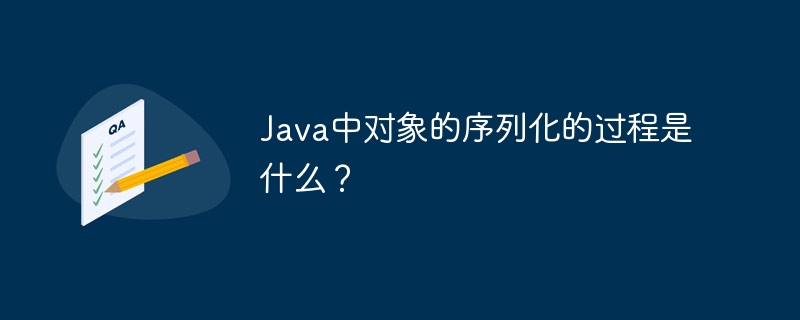Java中物件的序列化的過程是什麼?
在 Java 中,物件序列化將物件轉換為位元組流,反序列化則將位元組流還原為物件。序列化需要實作 Serializable 接口,準備物件並使用 ObjectOutputStream 寫入資料;反序列化則使用 ObjectInputStream 讀取資料並重建物件。例如,程式碼中序列化了一個具有 name 和 age 屬性的 Person 對象,並從檔案中反序列化以列印資訊。

Java 中物件的序列化過程
簡介
序列化是一種將物件轉換為位元組流並將其儲存在文件中或網路上的過程。反序列化則是將儲存的位元組流重新轉換為原始物件的相反過程。 Java 中物件序列化的核心介面是 Serializable。
序列化過程
1. 實作 Serializable 介面: 類別必須實作 Serializable 介面才能進行序列化。
2. 準備物件: 要序列化的物件必須實作 writeObject 方法,該方法將物件的欄位寫入輸出流。如果物件包含其他可序列化的對象,則 writeObject 方法也需要呼叫這些物件的 writeObject 方法。
3. 建立 ObjectOutputStream: 使用 ObjectOutputStream 將物件寫入輸出流。
4. 編寫物件: 呼叫 writeObject 方法將物件寫入輸出流。
反序列化過程
1. 建立 ObjectInputStream: 使用 ObjectInputStream 從輸入流讀取物件。
2. 讀取物件: 呼叫 readObject 方法從輸入流讀取物件。如果物件包含其他可序列化的對象,則 readObject 方法也會呼叫這些物件的 readObject 方法。
3. 重構物件: 從輸入流讀取所有資料後,將使用反射機制重構物件。
實戰案例
以下程式碼範例示範如何在 Java 中序列化和反序列化物件:
import java.io.*;
public class Person implements Serializable {
private String name;
private int age;
public Person(String name, int age) {
this.name = name;
this.age = age;
}
@Override
public void writeObject(ObjectOutputStream out) throws IOException {
out.writeObject(name);
out.writeInt(age);
}
@Override
public void readObject(ObjectInputStream in) throws IOException, ClassNotFoundException {
name = (String) in.readObject();
age = in.readInt();
}
public static void main(String[] args) {
try (ObjectOutputStream out = new ObjectOutputStream(new FileOutputStream("person.ser"))) {
Person person = new Person("John", 30);
out.writeObject(person);
} catch (IOException e) {
e.printStackTrace();
}
try (ObjectInputStream in = new ObjectInputStream(new FileInputStream("person.ser"))) {
Person person = (Person) in.readObject();
System.out.println(person.name + ", " + person.age);
} catch (IOException | ClassNotFoundException e) {
e.printStackTrace();
}
}
}以上是Java中物件的序列化的過程是什麼?的詳細內容。更多資訊請關注PHP中文網其他相關文章!

熱AI工具

Undresser.AI Undress
人工智慧驅動的應用程序,用於創建逼真的裸體照片

AI Clothes Remover
用於從照片中去除衣服的線上人工智慧工具。

Undress AI Tool
免費脫衣圖片

Clothoff.io
AI脫衣器

AI Hentai Generator
免費產生 AI 無盡。

熱門文章

熱工具

記事本++7.3.1
好用且免費的程式碼編輯器

SublimeText3漢化版
中文版,非常好用

禪工作室 13.0.1
強大的PHP整合開發環境

Dreamweaver CS6
視覺化網頁開發工具

SublimeText3 Mac版
神級程式碼編輯軟體(SublimeText3)

熱門話題
 Go語言中的物件序列化與反序列化
Jun 03, 2023 am 08:31 AM
Go語言中的物件序列化與反序列化
Jun 03, 2023 am 08:31 AM
隨著分散式伺服器技術的應用,物件序列化與反序列化這項功能在程式設計師的工作中變得愈發平凡。而在Go語言中,也提供了多種實現物件序列化與反序列化的方式,這些方式的使用場景也各不相同。本文將詳細介紹Go語言中物件序列化與反序列化的實作方式及其使用方法。一、什麼是物件序列化與反序列化?物件序列化和反序列化是指將一個物件資料結構轉換成可儲存或可傳輸的形式,以便於後續操
 如何自訂Java序列化?
Apr 15, 2024 pm 05:39 PM
如何自訂Java序列化?
Apr 15, 2024 pm 05:39 PM
自訂Java序列化有兩種方法:透過實作Serializable介面或建立自己的序列化程式。實作Serializable介面時,重寫writeObject()和readObject()方法可自訂序列化和反序列化。在建立自訂序列化程式時,重寫writeBytes()和readBytes()方法可完全控制序列化和反序列化過程。這在加密儲存敏感資料時很有用。
 Python 2.x 中如何使用pickle模組進行物件序列化
Jul 30, 2023 pm 06:07 PM
Python 2.x 中如何使用pickle模組進行物件序列化
Jul 30, 2023 pm 06:07 PM
Python是一門強大且易於使用的程式語言,它提供了許多內建模組和工具來幫助開發者完成各種任務。其中一個常用的模組是pickle,它允許我們將Python物件轉換為位元組流進行序列化和反序列化。本文將介紹Python2.x中如何使用pickle模組進行物件序列化,並提供一些程式碼範例。一、什麼是物件序列化物件序列化是指將物件轉化為位元組流的過程,使其可以在不同的
 Java中物件的序列化的過程是什麼?
Apr 12, 2024 am 11:30 AM
Java中物件的序列化的過程是什麼?
Apr 12, 2024 am 11:30 AM
在Java中,物件序列化將物件轉換為位元組流,反序列化則將位元組流還原為物件。序列化需要實作Serializable接口,準備物件並使用ObjectOutputStream寫入資料;反序列化則使用ObjectInputStream讀取資料並重建物件。例如,程式碼中序列化了一個具有name和age屬性的Person對象,並從檔案中反序列化以列印訊息。
 未來的Java序列化發展趨勢是什麼?
Apr 17, 2024 am 08:30 AM
未來的Java序列化發展趨勢是什麼?
Apr 17, 2024 am 08:30 AM
答:Java序列化格局正在改變,湧現出新的創新技術來滿足不斷變化的需求。詳細描述:Protobuf:Google開發的二進位格式,專注於速度和效率。 FlatBuffers:二進位格式,強調記憶體和CPU效能。 ApacheAvro:基於JSON的格式,提供模式相容性。 Jackson:處理JSON資料的庫,具有靈活性、效能和自訂功能。實戰案例:使用Protobuf將網路服務延遲降低了40%。未來趨勢:Protobuf、FlatBuffers和Avro將繼續佔據主導地位,同時也將出現滿足特定需求
 Redis與Ruby的點陣圖操作:如何實現高效率的數據分析
Jul 31, 2023 pm 01:01 PM
Redis與Ruby的點陣圖操作:如何實現高效率的數據分析
Jul 31, 2023 pm 01:01 PM
Redis與Ruby的點陣圖操作:如何實現高效率的資料分析引言:隨著大數據時代的到來,資料分析變得越來越重要。在資料分析過程中,點陣圖操作是一種常用且有效率的技術。本文將介紹如何使用Redis和Ruby來進行點陣圖操作,以實現高效率的資料分析。 Redis位圖操作簡介Redis是一種高效能的記憶體資料庫,而位圖是Redis中的一種資料結構,能夠用來表示大量的二進位位,並支持
 Python 3.x 中如何使用pickle模組進行物件序列化
Jul 31, 2023 pm 03:28 PM
Python 3.x 中如何使用pickle模組進行物件序列化
Jul 31, 2023 pm 03:28 PM
Python3.x中如何使用pickle模組進行物件序列化序列化是指將物件轉換為位元組流的過程,而反序列化則是將位元組流轉換回物件的過程。 Python中的pickle模組提供了一種簡單的方式來進行物件的序列化和反序列化操作。本文將介紹Python3.x中如何使用pickle模組進行物件序列化。首先,我們需要了解一些pickle的基本概念。在Python中
 如何防止Java序列化中的安全漏洞?
Apr 16, 2024 pm 12:36 PM
如何防止Java序列化中的安全漏洞?
Apr 16, 2024 pm 12:36 PM
防止Java序列化漏洞需要採取多管齊下的措施,包括:使用白名單限制可序列化的類別。使用過濾器檢查對象,驗證簽章或加密對象。禁用反序列化過程。隔離反序列化過程,在受控環境中執行。實施輸入驗證、使用安全編碼實踐,以及定期更新軟體和依賴項來強化應用程式。






